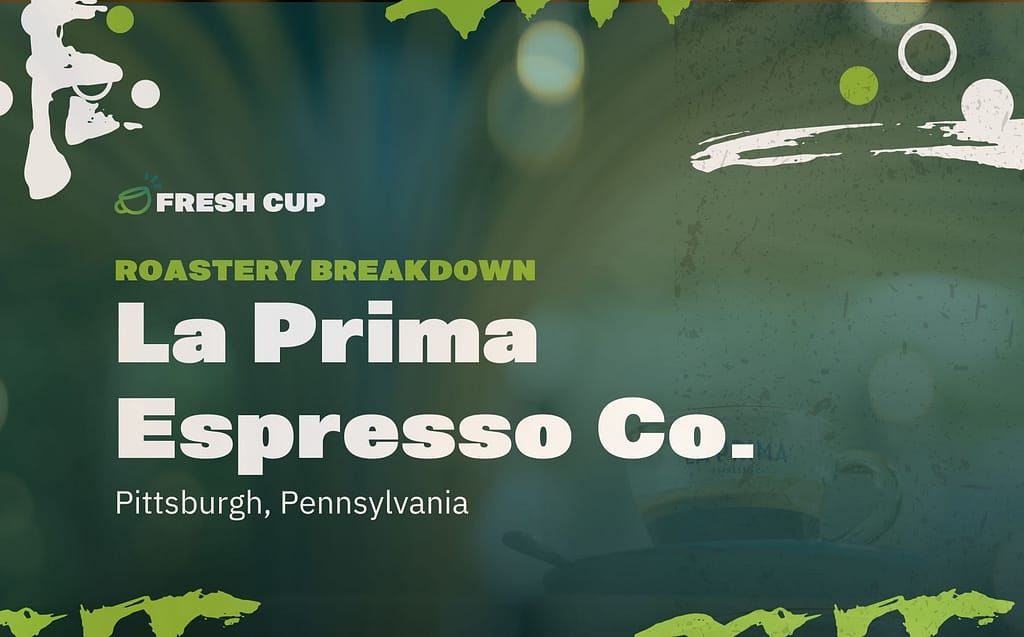[[{“value”:”
The Roastery Breakdown series is presented by our partner, Loring.
Picture a coffee roastery: you might imagine a space with rows of shelving, burlap bags of green coffee stacked high, and large roasters towering inside industrial-looking warehouses. Coffee equipment and cupping supplies are stored and pulled out for use to sample and taste different roasts. Roastery employees use pallet jacks and wheeled carts to move coffee through stations before it is shipped to customers and shops.
La Prima Espresso Co. in Pittsburgh fits all this action in a small space. For head roaster Chuck Connors and production manager Rob Moeller, keeping La Prima running at peak efficiency is about making use of every inch: maximizing the roastery space, maintaining separate tools for the brand’s organic certification, and keeping a tight roasting schedule.
Opened in 1988, La Prima began as an espresso machine showroom, a place for founder Sam Pitti to sell and fix coffee equipment. Eventually, the business evolved to include four locations and a coffee roastery with deep ties to the Italian-American community. Some of the blend offerings reflect that balance of Italian and American culture: the Miscela Bar, a lighter roasted coffee reminiscent of Northern Italian style espresso, is served alongside the La Prima Bar, a darker roasted blend evocative of more American style espresso.
The roastery provides coffee for all four of La Prima’s locations, its wholesale customers, and its online store. It is small for the amount of coffee it roasts and ships—3,000 square feet—but organized shelving and clear communication have been key in helping the team keep up with orders.
“We only have [enough] green coffee in-house that will get us through one week,” says Moeller. He explains that they’ve “got to be wise about how much [green coffee] we get because we can’t afford to have things sitting around the production floor. They have to be put away, and we have to be on this tight schedule.”
La Prima’s roastery space also stores espresso machines, bar gear, and syrups for wholesale clients, so maximizing space is vital to the team’s success.
Roastery Location: Pittsburgh, PennsylvaniaSquare Footage: 3,000 square feetPounds Roasted: 4,600 pounds per weekRetail and/or Wholesale Roasting: Both
La Prima roasts to order, meaning they roast coffee to accommodate orders placed instead of roasting coffee to keep a certain level of roasted coffee on hand. “We are roasting every single day for orders that will be packed and shipped the next day,” says Moeller. “We have to balance the customer needs and orders per day so we are not overwhelmed in the space and so we are never waiting for coffee.”
Before purchasing their 35-kilo Loring Kestrel, the team at La Prima roasted coffee on two San Franciscan SF-25s. The SF-25s can roast 25 pounds at a time, so bringing in a larger roaster with more automation features increased output and made the roasting process more efficient.
“We can crank out coffee a little quicker, and the access to real-time data that you can see visually and adjust with great accuracy is like another world from roasting on these traditional drum roasters that we had,” says Conners.
Moeller describes the upgrade as a “big improvement on workflow to have these programmed roast profiles [because] you don’t have to run back and forth between two machines and try to make sure that the roasts are consistent.”
With such a small space and thousands of pounds of coffee to roast, organization is the name of the game for the team at La Prima. The tools and systems they use to orient the roasting space help keep things running smoothly.
Google Spreadsheets
La Prima’s team uses a custom-built Google Spreadsheet that converts the number of coffee orders placed into batch sizes. The spreadsheet tells the roasting team exactly how much coffee they need to roast daily.
“This system allows us to bypass the managerial work of setting and adjusting par levels, keeps the coffee very fresh for customers, and allows the production staff to fill bags [instead of] waiting for coffee to be roasted,” says Moeller.”
Separate Stations
Organic coffee sparks a lot of discussion in the coffee industry—maintaining an organic coffee certification at roasteries like La Prima involves implementing strict procedures for handling organic and non-organic coffees throughout the space.
Fourteen of La Prima’s 24 coffees are certified organic and must be handled separately from non-organic beans throughout the roasting process. “The two streams cannot cross,” says Conners.
To maintain organic certification, La Prima set up two separate stations for preparing and packaging coffee. Each station has its own tools, such as scoops, labels, and grinders.
Any tool that touches organic beans cannot be used for non-organic beans—even coffee beans must be stored separately. So, the roasting team uses color-coded storage bins: green barrels are for organic beans, and gray barrels are for non-organic. With bigger equipment like the Loring, the team cleans and purges the roaster in between with a burner batch of organic coffee.
It seems like a lot of work, but with a smile and shrug, Conners says, “People comment on it, but now we’re so used to it that it’s not really an issue for us anymore.”
Food Grade Mixer
La Prima prides itself on its blends, and with hundreds of orders to fulfill comes hundreds of pounds of coffee to blend.
Adding a food-grade mixer to their roastery has lightened the work of blending considerably. “We have a food-grade mixer that can hold about 70 pounds of coffee,” said Moeller. “We throw it in there, give it a good stir, wait a few minutes, and then scoop.” The mixer is one of the few products that does not need a twin or duplicate for organic coffees. It can be cleaned between mixes, but Conners says that most of the blends mixed in the mixer are organic.
Most roasters only serve a handful of blends, but La Prima’s tight organizational system has allowed it to build a wide selection. Conners says he highlights this when talking to wholesale clients: “We like to focus on blends because anyone can take a single-origin coffee—it’s not necessarily going to be the same from three different roasters, but it’s going to be fairly similar. [Blends] are unique to us.”
Many of the blends La Prima sells support community efforts and raise funds for local causes.
For example, the Rachel Carson blend is named after the Pittsburgh-born environmentalist. La Prima donates $1 for every pound of the blend sold to Chatham University’s Falk School of Sustainability and Environment. “There’s an organization, a local food waste elimination organization called 412 Food Rescue. We have a blend [called Rescue Hero] in their honor, and we donate some of the proceeds to that organization,” says Conners.
From its humble beginnings as an espresso showcase space to a nationally-recognized roastery, La Prima has cemented its place in both the local community and the broader coffee sector by staying organized. Organization has allowed the brand to thrive —by implementing reliable systems, they’ve honed in on what makes their brand unique: signature blends that speak to the brand’s Italian-American roots, uphold La Prima’s commitment to sourcing organic coffees, and improve the community.
“}]]


